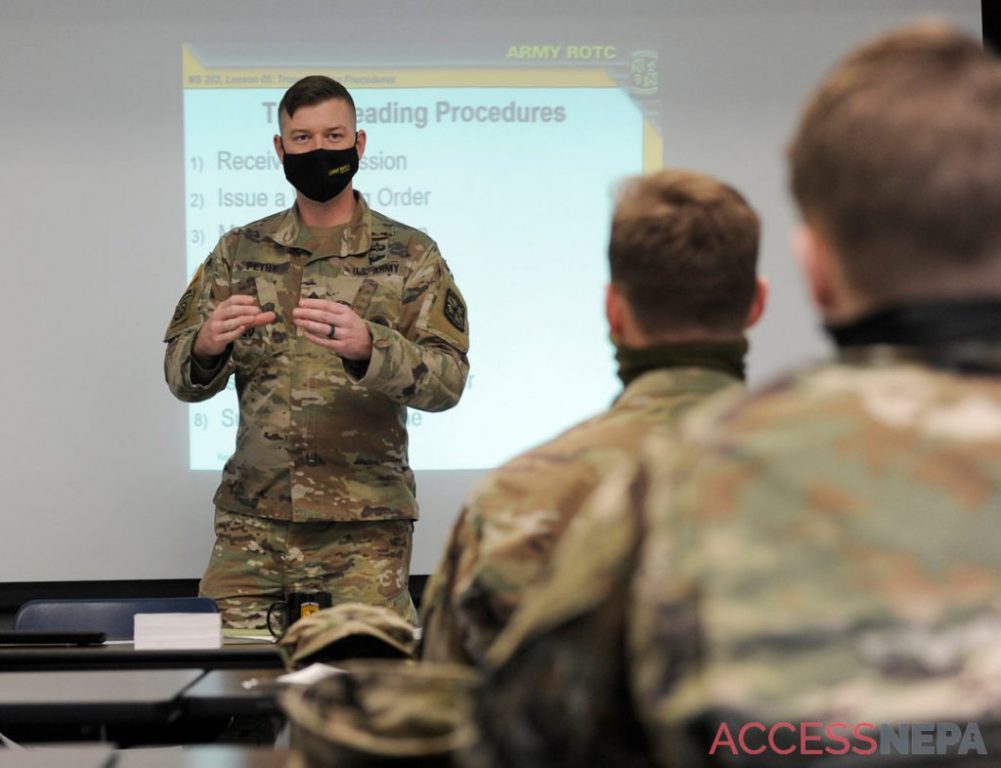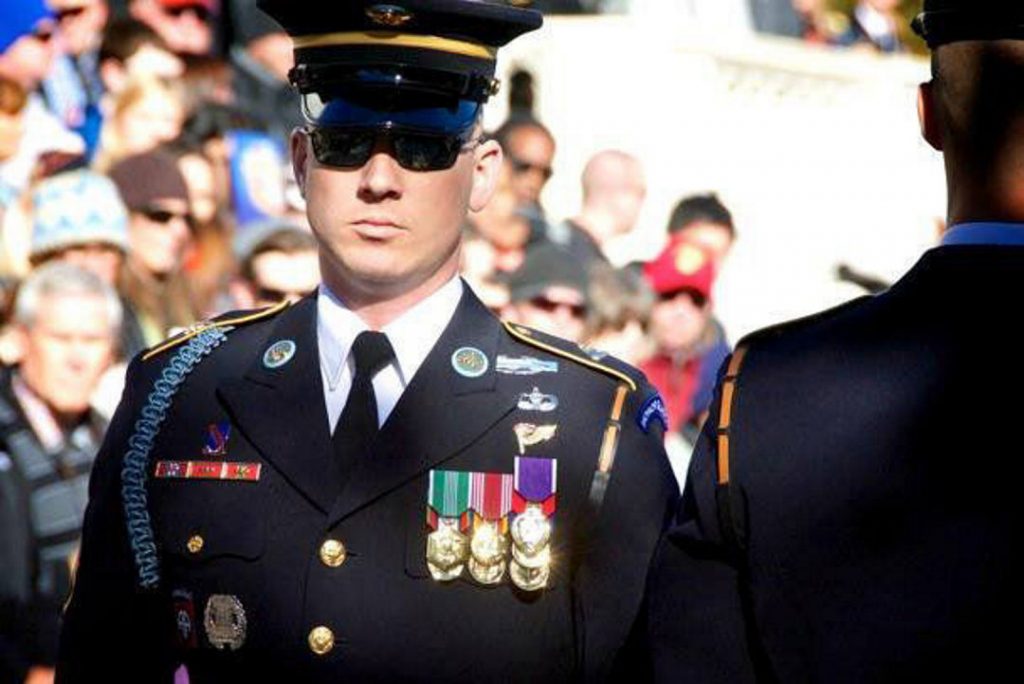From overseas combat to guarding the Tomb of the Unknown Soldier, U.S. Army Sgt. 1st Class Rob Petry has seen a lot, and he’s drawing on his experience to train the Army’s future leaders who currently attend college in Luzerne County.
Petry took an assignment as military service instructor for the Army’s ROTC program at King’s College in May 2019.
“It is something that I wanted to do. The way it works in the Army is when you are a senior NCO (non-commissioned officer), you talk with your branch manager and say, ‘Where does the Army need a person with my qualifications right now?’ It’s a conversation back and forth. I was given a few options and chose to come to the Scranton/Wilkes-Barre area and serve as an ROTC instructor.”
Petry, 36, of Cabin Creek, West Virginia, had his pick of several assignments in various parts of the country. He chose the one at King’s College because it was the closest to his hometown.
“And I’m also a real big fan of ‘The Office,’” Petry said with a chuckle, referring to the mockumentary TV series that followed the lives of employees at a Scranton paper company.“I love it. It’s a great job,” Petry said. “I like knowing that I can have some influence in shaping the Army’s future officers. It’s nice to use lessons learned from my experience to make sure that they will be successful when they do end up going into the Army.”
Basics to command
Hosting 38 cadets, King’s is one of three Northeastern Pennsylvania colleges that offer Army ROTC classes; the others are East Stroudsburg University and the University of Scranton, which serves as the main site for this region’s battalion.
Cadets attending Wilkes University, Misericordia University and Penn State Wilkes-Barre are cross-enrolled at King’s so they can participate in the program, which offers college credits as well as scholarships.
“We tend to get a lot of freshmen because they’re interested,” Petry said. “Over the course of sophomore and junior years, some decide to disenroll because they’re trying it out and they decide it’s not for them. Most cadets do decide to contract and commission as (second) lieutenants. A lot of cadets choose to contract in their freshmen and sophomore years.”
Cadets start with the basics, which Petry calls “customs and courtesies — the right way to wear the Army uniform, standards for personal appearance … how to stand at attention, how to operate in a formation.” By the time they’re seniors, “they’ll be running the battalion as battalion commander, battalion sergeant major and other staff positions. … We get them used to the Army command structure and we get them used to operating in leadership positions over each other.”
Fortunately, Petry said, the coronavirus pandemic has not caused any significant disruption to the program. He utilized distance learning, social distancing and other protocols to ensure field training exercises and weekly labs in areas such as marksmanship and weapon disassembly and reassembly continued.

MARK MORAN / STAFF PHOTOGRAPHER
Army Sgt. 1st Class Rob Petry teaches cadets in the King’s College Army ROTC program.
Lessons learned
A non-commissioned officer, Petry enlisted when he was 20 and worked his way up in rank. Although graduating seniors will technically outrank him when they enter the Army, experienced officers such as Petry advise the newly minted officers, fresh out of college, as they begin their military careers.
After basic training, Petry was assigned to the 82nd Airborne Division in Fort Bragg, North Carolina, and served a 15-month stint in Afghanistan during Operation Enduring Freedom. He re-enlisted to go to Fort Carson, Colorado, with the 4th Infantry Division and deployed to Afghanistan again for another 13 months.
Petry said it’s important “to make sure others don’t make the same mistakes in the future. So, I do use my past experiences in Afghanistan as lessons learned of what to do and what not to do in certain situations.”
He then spent about two years as a “black hat” instructor at U.S. Army Airborne School at Fort Benning, Georgia, before volunteering to join the 3rd Infantry Regiment, whose members are responsible for conducting full-honor military funeral ceremonies at Arlington National Cemetery in Virginia. He then served in Germany with the 2nd Cavalry Regiment as a platoon sergeant and a first sergeant before taking the ROTC post in Wilkes-Barre.
About two months after joining the 3rd Infantry Regiment, commonly known as the Old Guard, Petry tried out to serve in the platoon responsible for guarding the Tomb of the Unknown Soldier, and he was accepted. He volunteered for the 3rd Infantry Regiment with that goal in mind.
“Knowing what the Tomb of the Unknown Soldier represents and having been involved in combat operations in Afghanistan made me want to give something back and honor America’s unknown soldiers,” Petry said. “It seemed like the best way to give back to our honored dead.”
A place to grieve
Petry explained that prior to the Vietnam War, there was no good system in place for identifying the remains of all soldiers killed in battle.
“What that means is, those families — their wives, their children, their parents — never received any closure,” Petry said. “There are thousands of grave markers all over the world that just say ‘unknown soldier’ on them. They’re in France, they’re in Korea, they’re all over the place.”
“The Tomb of the Unknown Soldier was put in place after World War I so those families would have a place to go and grieve their loss. And one unknown soldier’s remains were selected at random to be placed under the tomb. … However, it was meant to represent all unknown soldiers from the past, from all previous American wars,” Petry said.
Petry, who served as sergeant in charge, described the experience as humbling. Tomb guards, he said, spend countless hours working on guard change and wreath laying ceremonies and making sure their uniforms are impeccable. And while the uniforms and the ceremony help draw visitors to the cemetery, they’re not meant to be the focal point, he said.
“The goal is that they look past us and see the unknowns who are buried there and what they represent,” Petry said. “They represent American citizens who not only sacrificed their lives, but they sacrificed their identities in their service to this nation. … It’s humbling to know no matter how hard we work on our uniforms or how much lack of sleep we deal with, it will never compare to what they had to sacrifice.”

SUBMITTED PHOTO
Sgt. First Class Rob Petry, Army ROTC instructor at King’s College, previously served as sergeant in charge at the Tomb of the Unknown Soldier in Arlington National Cemetery.
Exploring possibilities
Petry said his time with the 3rd Regiment is among the experiences he’s talked about with his cadets, although many were already aware of his time there because a video of him conducting a rifle inspection at the tomb in 2014 went viral on YouTube, with more than 10 million views to date and the subject of memes and some comedy videos.
“The biggest thing I’ve learned from my time in the Army, from any of the duty stations I’ve been in … is the people that you serve with, you learn to really rely on each other,” Petry said. “When you know other people are relying on you and you’re relying on other people, you form a strong bond with your coworkers and people that you are in the same small units with.”
Petry said the Army can provide a fulfilling career, and the ROTC program offers an unparalleled opportunity to explore the possibilities.
“It’s a great learning opportunity even if you decide not to stay in the program and get commissioned. It’s still worth college credit just like other elective classes,” Petry said. “You can come see what it’s all about.”




